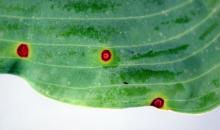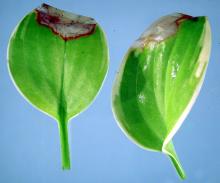See:
Greenhouse Plants, Ornamental - Gray Mold
Cause Botrytis cinerea (sexual: Botryotinia fuckeliana) and other Botrytis spp., fungi that colonize dead, dying, and wounded plant parts. From these infections they can attack healthy tissues. A moist, humid environment is ideal for pathogen sporulation and spread. Spore dispersal is stimulated by changes in relative humidity. It is found everywhere plants are grown and has a wide host range wide host range including African violet, ageratum, ajuga, aphelandra, aster, begonia, caladium, calceolaria, carnation, chrysanthemum, coleus, cyclamen, fuchsia, geranium, gloxinia, hosta, Iberis, impatiens, lily, lobelia, marigold, orchid, pansy, Pericallis hybrids, petunia, poinsettia, primrose, rose, snapdragon, verbena, viburnum, zinnia, and zygopetalum. Leaf blights can start when infected floral tissue falls on healthy leaves. Unrooted cuttings in propagation are very sensitive since the excess water needed for rooting promotes this disease. Plant parts, such as roots, corms, rhizomes and stems, in cold storage can also be injured.
Of the hundred hosta samples sent into the OSU Plant Clinic since the 1994, most have been diagnosed with Host virus X, but many have also been diagnosed with Botrytis leaf spot.
Symptoms Leaf spots and blights with dark halos around the margins are the most common symptom. Initial infections appear as water-soaked brown to tan spots. In humid conditions, a fuzzy fungal growth, brown to gray, appears around the infected plant part. Infections move quickly to healthy tissues under ideal conditions. The lesions can spread down the leaf petiole and sometimes can be found beneath the soil surface.
Cultural control An integrated strategy combining environmental management, cultural practices, and fungicides will most effectively manage this disease.
- Remove all dead and dying plant parts (particularly blossoms) on and around plants.
- Maintain a steady, relatively dry environment by keeping greenhouse humidity below 90%, increasing spacing between plants for good air circulation, and taking care not to splash water on foliage during watering. Heating the greenhouse at night (especially for zero or negative DIF) or venting around sunset may be necessary. Heating in the morning before sunup can also help prevent dew formation as air temperature increases faster than the temperature of plant parts. If using DROP or DIP for size control, do not let humidity rise above 90%.
- Spacing plants also allows better light penetration, reducing senescence of the lower leaves and thus helping reduce the amount of highly susceptible plant tissue.
- Place fans in greenhouse to get better air circulation.
Chemical control Fungicides do not compensate for poor sanitation or environmental controls. Resistance to many different and multiple fungicide groups has been documented worldwide. It is common for an isolate to be resistant to 4 different FRAC groups and isolates resistant to 7 different FRAC groups at once has been detected. To prevent developing resistant fungi, alternate or tank-mix materials from different groups with different modes of action. Also, limit applications from any specific group to two (2) or fewer sprays. Although many different fungicides could be used, they are not typically labeled specifically for hosta. Be sure to check labels for crop safety before application.
References Hausbeck, M.K. and Moorman, G.W. 1996. Managing Botrytis in greenhouse-grown flower crops. Plant Disease 80:1212-1219.
Lukasko, N. T. and Hausbeck, M. K., 2024. Resistance to seven site-specific fungicides in Botrytis cinerea from greenhouse-grown ornamentals. Plant Disease, 108:278-285.



